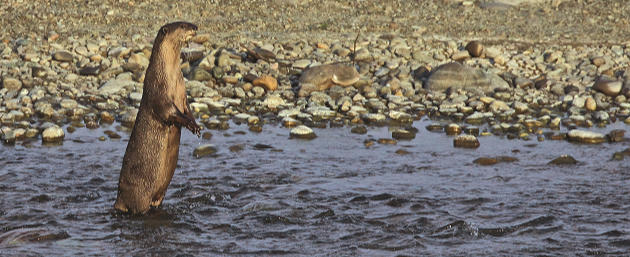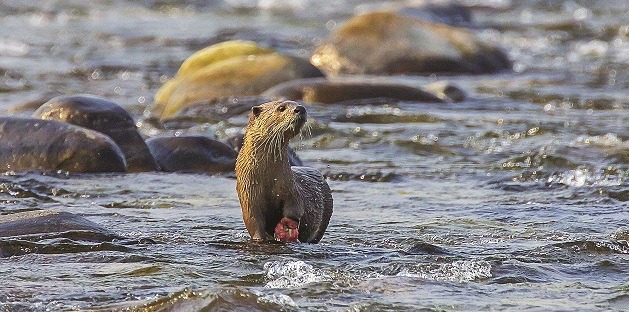Custodians of the Ramganga
First published in Sanctuary Asia,
Vol. 36
No. 6,
June 2016
By Daanish Shastri
Tigers, elephants, leopards and a host of mammals and birds inhabit the truly wild and stunningly beautiful natural ecosystems around the Ramganga river. Sanctuary Wildlife Photographer of 2014 Daanish Shastri has been visiting the Jim Corbett National Park in Uttarakhand regularly since he was a toddler. This winter, the 1,300 sq. km. Protected Area in the foothills of the Himalaya, rewarded him with yet another unique experience – a weekend with the otters of the Ramganga.
Crossing lakdi-ka-pul with my driver-cum-guide Arif Pukaka, we were heading for the isolated lair of tigress Paarwaali aka Paaro, literally ‘the tigress across the bank’. This is where I glimpsed from the corner of my eye what seemed like a shoal of fish swimming straight toward us. By this time we had crossed the makeshift bridge and were in three feet of water in the middle of the river. Closer scrutiny through the zoom lens of my camera revealed that it was not fish but a bevy of otters heading for their holt on the banks of the river. And we were in their way! A few seconds later, the entire group stood up on its hind legs and regarded Arif, me and our Gypsy with unbridled and indignant curiosity. Having thus established that we were not a threat, the group re-adjusted its coordinates and dived in again in a bid to bypass us. The grace with which they moved sent the adrenaline rushing through my veins. So mesmerised was I with their antics that I forgot all about Paaro and her cubs, and dedicated the rest of my weekend to the otters of the Ramganga.
Otter Realities
The Indian smooth-coated otters that so entertained us that weekend were, at one time, the alpha predators in most fresh waterbodies in north India. Today, they are an endangered species and the few that remain inhabit protected forests including Kaziranga, Dudhwa and Corbett National Parks. The 2003 award-winning documentary produced by filmmaker Syed Fayaz And Then There Were None vividly portrays the problem of poaching, which led to the near disappearance of otters from Kashmir’s Wullar Lake area. The infamous Indian wildlife trader Sansar Chand reportedly supplied almost 4,000 otter skins to Nepalese and Tibetan buyers. The population of otters in the Changbaishan Mountain Nature Reserve of northeastern China declined by over 99 per cent, from over a lakh and a quarter in 1975 to just a few hundred today. Otter pelts accompany almost every seizure of tiger and leopard skins, and Tibet and China remain the primary buyers, where otter fur is part of the traditional Tibetan dress – chuba. The demand persists despite appeals by religious and political leaders, including the Dalai Lama, to desist from this practice.
Otters are widely believed to be crepuscular, active only around dawn and dusk. But surprisingly, our encounters with otters in the Ramganga river were almost always in bright daylight.
The Indian smooth-coated otter is characterised by its glistening, sleek pelage. It has a flattened tail and its limbs are strong and short, while the feet are large and webbed. It is generally described as a fish specialist and hunts in groups, travelling upstream in a V-formation while fishing. A small fish is swallowed whole while larger fish are taken to shore to eat at leisure. The otter is one of the very few aquatic mammals that does not have blubber to maintain body heat. An average otter must eat approximately 20 per cent of its body mass every day in order to maintain its high metabolic rate and keep itself warm. Otters play a vital role in the ecological balance of the Ramganga. Without otters to regulate prey populations, an overabundance of smaller animals and fish could result in depletion of other animals and plants in the food web, thus disrupting the balance of the whole river system.

With the water droplets on its coat glistening in the late-morning sun, an otter stands up on two legs to curiously survey its surrounds. Photo Courtesy: Daanish Shastri
Survival Tales
The family of otters inhabiting lakdi-ka-pul in the Ramganga rewarded us with several sightings almost everyday. A patient wait of no more than an hour, and one or the other would pop its head around the river bend or from behind a rock or emerge right beside me in the water. Our persistent presence at the same spot possibly allowed them to forget their inhibitions and consider us as part of their habitat. It was on the fourth day that we saw an injured otter. She was part of a group of eight heading straight for the bridge towards their holt on the far bank in the east. Her left foreleg was severely injured, with the webbed portion missing as the exposed bone protruded out of the raw flesh. She was finding it difficult to swim but the other otters displayed surprising social behaviour, helping her climb, and even depositing fish on the bank for her to feed on.
On our fifth day, we met Deputy Director of Corbett National Park, Saket Badola, who was patrolling along the riverbed with the entire ground team of Dhikala, Khinnanauli and Sarapduli to investigate the condition of the injured otter and to counter any possible poaching attempts. We observed the team set up camera traps to get a closer look at the otter and determine her condition with minimal human intervention. The camera traps yielded results that very evening. Forest guard Sharat Singh Bisth informed me that the cause of the injury was not poachers but possibly a floating wire in which the otter may have been ensnared. The team of forest officials led alternately by Field Director Samir Sinha and the Deputy Director had sanitised the entire length of the river from Gairal to the reservoir to determine the probable cause. The search yielded no tell-tale signs of snares or traps. After a detailed analysis of the footage, the Forest Department concurred that the injured otter was healing well and there was no need for human intervention.

This bevy of otters inhabits a stretch of the river around lakdi-ka-pul in Corbett. Wait patiently at one spot, and they might pop into view. Photo Courtesy: Daanish Shastri
I spent quiet evenings at the Dhikala camp collecting information on otters. I found that despite such attention to detail by dedicated forest officials, otter numbers are on the decline. Unlike tigers, which have caught the nation’s imagination, otters remain in the backwaters and continue to be hunted mercilessly.
As the sun set over the Ramganga valley, I wondered how many more such weekends we could enjoy in the lap of nature. The otters swam around me in the golden light of the setting sun, oblivious to their fate. My heart sank with the sinking sun, as the image of the otters assisting their injured mate came to mind. They were fighting for her survival while humans plot their eventual demise.

The author observed surprising, cooperative behaviour amongst the lakdi-ka-pul otters. This injured female was assisted by other members of her group who helped her climb over rocks and deposited fish for her to eat. Photo Courtesy: Daanish Shastri




